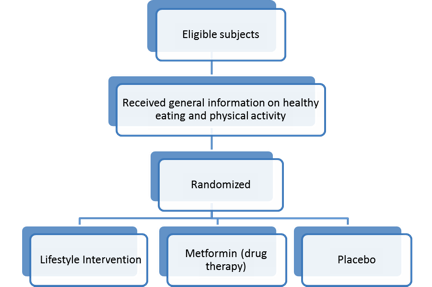
The Diabetes Prevention Program Research Study
The Diabetes Prevention Program (DPP) was a major multicenter clinical research study that examined whether 1) modest weight loss through dietary changes and increased physical activity or 2) treatment with the oral diabetes drug metformin (trade named Glucophage) could prevent or delay the onset of type 2 diabetes.
 All study subjects were overweight and had impaired glucose tolerance (IGT), now known as prediabetes. In addition, 45% of the subjects were from minority groups—African Americans, Alaska Natives, American Indians, Asian Americans, Hispanics, or Pacific Islanders—and therefore at an increased risk for diabetes.
All study subjects were overweight and had impaired glucose tolerance (IGT), now known as prediabetes. In addition, 45% of the subjects were from minority groups—African Americans, Alaska Natives, American Indians, Asian Americans, Hispanics, or Pacific Islanders—and therefore at an increased risk for diabetes.
The DPP research study had 3,234 subjects at 27 clinical centers around the United States.
Study Design
At each clinical center, subjects were randomly assigned to one of three treatment groups:
- Lifestyle intervention: subjects received intensive individual counseling on diet, exercise, and behavior modification. Subjects set a goal of losing at least 7% of their body weight by eating less fat and fewer calories and exercising for a minimum of 150 minutes per week.
- Drug therapy: subjects received 850 mg of metformin (a drug to treat diabetes) twice per day and were given general information on diet and exercise.
- Placebo: subjects received placebo pills instead of metformin and were given general information on diet and exercise.
Study Design cont’d
Subjects in all three groups were followed for several years to determine if and when they got type 2 diabetes.

DPP Lifestyle Intervention
The lifestyle intervention arm of the DPP research study was an intensive program designed to help subjects achieve two goals:
- Lose a modest amount of weight (at least 7% reduction in baseline weight) with long-term maintenance
- Do at least 150 minutes per week of physical activity equivalent to brisk walking
All subjects were given the same weight loss and physical activity goals, and health care professional staff worked with each to overcome barriers to reaching those goals.
DPP Lifestyle Intervention cont'd
The 7% body weight reduction goal was based on data and findings from previous studies that suggested weight loss at this level was achievable within 24 weeks. Subjects were assigned fat gram (and sometimes calorie) goals and used self-monitoring techniques to track their dietary intake.
The physical activity goal of at least 150 minutes per week was adopted because evidence from previous research studies found this goal to be feasible, maintainable, and likely to be beneficial in helping subjects maintain their weight loss. The DPP lifestyle intervention encouraged subjects to take up brisk walking. However, some participants chose to engage in other physical activities of similar intensity.DPP Curriculum
Core Sessions
 The DPP curriculum consisted of 16 one-on-one counseling sessions held weekly. The 16 structured sessions covered several topics:
The DPP curriculum consisted of 16 one-on-one counseling sessions held weekly. The 16 structured sessions covered several topics:
- Sessions 1-8 focused on the fundamental skills required of participants to achieve their goals. Topics covered included self-monitoring food intake, physical activity, and body weight; lowering fat and calories; eating healthfully; developing a physically active lifestyle; and learning behavioral self-management strategies.
- Sessions 9-16 focused on the psychological, social, and motivational elements of lifestyle change with emphasis on recognizing and overcoming factors that interfere with attaining program goals.
DPP Curriculum cont’d
Post-Core Sessions
After the 16-session core curriculum, subjects entered a post-core phase during which they attended sessions at least once every 2 months and received phone calls at least once between sessions. This phase of the program was less structured, and the health care professionals leading it were encouraged to focus on topics of interest to subjects rather than follow a set curriculum.
Program Resources
Many resources were available to study subjects and to the clinical centers within the DPP research study. In addition to one-on-one counseling, subjects had access to the following:
Hover your mouse over each resource below for details.
What did the Study Find?
 After 3 years, DPP researchers found that members of the lifestyle intervention group sharply reduced their risk for type 2 diabetes. Overall, subjects in the lifestyle intervention group reduced their risk for type 2 diabetes by 58% when compared to subjects in the placebo group. This finding was evident for all participants, regardless of sex, age, race, or socioeconomic status. For participants aged 60 or older, the findings were even more dramatic: they reduced their risk by 71% when compared to the placebo group.
After 3 years, DPP researchers found that members of the lifestyle intervention group sharply reduced their risk for type 2 diabetes. Overall, subjects in the lifestyle intervention group reduced their risk for type 2 diabetes by 58% when compared to subjects in the placebo group. This finding was evident for all participants, regardless of sex, age, race, or socioeconomic status. For participants aged 60 or older, the findings were even more dramatic: they reduced their risk by 71% when compared to the placebo group.
 Subjects who took metformin reduced their risk for diabetes by 31% more than did subjects in the placebo group. Therefore the drug therapy was about half as effective as the lifestyle program.
Subjects who took metformin reduced their risk for diabetes by 31% more than did subjects in the placebo group. Therefore the drug therapy was about half as effective as the lifestyle program.
The DPP findings were published in the February 7, 2002 issue of the New England Journal of Medicine.
Members of the lifestyle intervention group reduced their risk for diabetes by 58% when compared with the placebo group. This finding was evident for all subjects, regardless of sex, age, race, or socioeconomic status.
The DPP research study clearly demonstrates that the lifestyle intervention can be delivered to virtually anyone with prediabetes and achieve effective results.
Did All Participants Reach Their Goals?
Does this significant reduction in risk mean that every participant reached his or her goal? The answer is no - some did reach their goals, and some did not. The overall results of the lifestyle intervention group are as follows:
- Average weight loss: 14.5 lbs.
- Percentage of subjects who reached or surpassed the 7% weight loss goal: 49.7%.
- Average weekly physical activity: 224 minutes.
- Percentage who reached or surpassed the 150-minute weekly activity goal: 74.4%.
These data clearly demonstrate the potency of weight loss in reducing risk for type 2 diabetes among people with prediabetes. Even though less than 50% of subjects hit the 7% goal, most subjects did lose some weight. Thus, the DPP research study demonstrates the overall effectiveness of weight loss on reducing risk for type 2 diabetes.
Findings on Weight Loss and Diabetes Risk
 One of the most important findings from the DPP research study is that weight loss was the most important factor in lowering the risk for type 2 diabetes. Furthermore, the effect of weight loss on the risk for type 2 diabetes was not modified by age, sex, ethnic group, or level of physical activity. In other words, not only was weight loss the most important factor in lowering risk for type 2 diabetes, but it had the same effect across all populations regardless of other risk factors. Increasing physical activity without losing weight only modestly reduced risk for type 2 diabetes.
One of the most important findings from the DPP research study is that weight loss was the most important factor in lowering the risk for type 2 diabetes. Furthermore, the effect of weight loss on the risk for type 2 diabetes was not modified by age, sex, ethnic group, or level of physical activity. In other words, not only was weight loss the most important factor in lowering risk for type 2 diabetes, but it had the same effect across all populations regardless of other risk factors. Increasing physical activity without losing weight only modestly reduced risk for type 2 diabetes.
In addition, subjects who reported eating the lowest percentage of calories from fat decreased their risk further with every kilogram of weight loss. This finding shows an added benefit to dietary fat gram reduction.
Weight loss is the most important factor in lowering the risk for type 2 diabetes in all populations, regardless of other risk factors.
Implications of the DPP Research Study
 The results of the DPP research study suggest that the millions of people in the United States with prediabetes can lower their risk for type 2 diabetes by losing modest amounts of weight by decreasing fat and calorie intake and participating regularly in physical activity. It also demonstrates the particular importance of weight loss.
The results of the DPP research study suggest that the millions of people in the United States with prediabetes can lower their risk for type 2 diabetes by losing modest amounts of weight by decreasing fat and calorie intake and participating regularly in physical activity. It also demonstrates the particular importance of weight loss.
For every 2.2 pounds of weight loss achieved, risk for type 2 diabetes was reduced by 13%.
Implications of the DPP Research Study cont'd
The DPP research study also shows that metformin may be effective in delaying the onset of type 2 diabetes but, in most cases, not as effective as structured lifestyle change.
What Happened Since the DPP Research Study?
The lifestyle intervention arm of the DPP research study was highly successful but at a financial cost that could be prohibitive in real-world settings. The challenge is how to make the lifestyle intervention widely accessible and affordable.
Several programs were adapted from the DPP research study, and they show significant promise at lowering cost, producing similar results, and increasing the number of people who can participate in a diabetes prevention program. These adapted programs are operated in various settings (e.g., health care facilities, worksites, and community-based organizations, especially the YMCA) and for various ethnic and racial groups. Next are details about some of the characteristics of the adapted programs:
What Happened Since the DPP Research Study? cont'd
Characteristics of programs adapted from the DPP:
Hover your mouse over each bullet point below for details
Some programs produced the same or similar results as the DPP research study in reducing the risk for type 2 diabetes among people at risk for the disease. This finding is important because it indicates that low-cost, group-based programs can be successful in reducing the rates of type 2 diabetes.
Several low-cost, group programs based on the DPP research study produced similar results in reducing the risk for type 2 diabetes among people at risk for the disease.
Summary
The results of the DPP research study indicate that the millions of people in the United States who are at high risk for type 2 diabetes can prevent or delay the disease by making modest lifestyle changes through a structured program. The study demonstrated that weight loss and physical activity lower the risk for type 2 diabetes by improving the body’s ability to use and process glucose. Several programs were adapted from the DPP research study, and they show significant promise at lowering cost, producing similar results, and increasing the number of people who can participate in a diabetes prevention program.
Take Home Messages
- The goal of the DPP research study was to test whether modest weight loss through dietary changes and increased physical activity or treatment with the oral diabetes drug metformin could prevent or delay type 2 diabetes among people with prediabetes.
- Subjects in the lifestyle intervention group of the DPP research study reduced their risk for type 2 diabetes by 58% when compared to members of the placebo group. For subjects aged 60 or older, the findings were even more dramatic: they reduced their risk by 71% when compared to the placebo group.
- Subjects in the metformin drug therapy group reduced their risk for type 2 diabetes by 31% when compared to the placebo group.
- The DPP research study lifestyle intervention was effective regardless of a subject’s age, race, sex, or socioeconomic status.
- Weight loss was the most important factor in lowering risk for type 2 diabetes.
Take Home Messages cont'd
- Several programs were adapted from the DPP research study, and they show significant promise at lowering cost, producing similar results, and increasing the number of people who can participate in a diabetes prevention program.
- The results of the DPP research study and later studies suggest that the millions of people in the United States with prediabetes can prevent or delay type 2 diabetes by participating in a structured lifestyle program that helps them lose a modest amount of weight by decreasing fat and calorie intake and engaging in regular physical activity.
Other Resources
For more information on the Diabetes Prevention Program:
- National Diabetes Information Clearinghouse (NDIC) – Diabetes Prevention Program
- George Washington University – Original DPP website where you can find information about the study as well as the original curriculum

